Question and Answer – February 2010
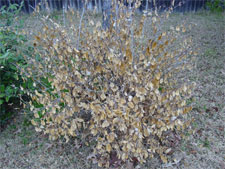
Question: I have a row of elaeagnus. Last year, one plant in the middle of the row quickly died. Two others have since then, and two more seem to be declining. I cannot find any information about possible reasons that this durable plant would do this. C.H., Keller.
Answer: You’re right – elaeagnus is one of our most trouble-free plants. However, it really looks like cotton root rot might be involved with this row. It typically starts with one plant, then spreads to the plants on either side. It’s a soil-borne fungal disease that is prevalent in alkaline soils, most especially the black clays around the DFW Metroplex. It can lie dormant in the soil for many years, then suddenly become active and kill established trees and shrubs. It attacks probably 80 percent of the species we grow in our Texas landscapes, but some are notoriously susceptible (Indian hawthorns, apples, pears, roses, silver maples, etc.). The best way to tell if it’s involved is to collect a generous set of root samples (8 or 10 roots pencil-sized or preferably larger). Put them into a large zipping bag (no extra moisture, please), and send them to the Plant Disease Diagnostic Lab at Texas A&M. Plants that are resistant to the organism include oaks, hollies, junipers and nandinas. Of course, you also want to rule out odd possibilities such as gas leaks and weedkiller spills.
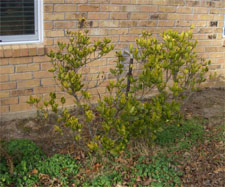
Question: What makes my azaleas and gardenias fade like this? Any remedy? S.C., no city given.
Answer: If ever there were the need to have the city given for a question, this is it! Please, oh please, tell me where the plants are growing when you write me.
This looks like iron deficiency, and that will certainly be the case if you live in an area with alkaline soil. Both types of plants need copious amounts of soluble iron, and alkaline soils (and alkaline irrigation water) cause iron to become insoluble. This plant looks like it really needs to have been planted in a raised bed and into soil that had been enriched (or replaced) by a very high percentage of Canadian peat moss and other organic matter. You’ll probably be better off reworking the bed and buying a few new plants than to spend money and time trying to get these turned around.
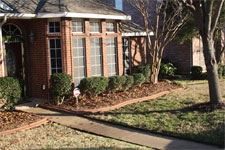
Question: I have a spot between my Bradford pear tree and the landscape bed. Bermudagrass just won’t grow there, probably due to insufficient sun. I’d like to extend the bed out to include the pear tree. What would a good groundcover be? M.R., Allen.
Answer: I’d suggest purple wintercreeper euonymus or Asian jasmine. These are outstanding choices in both sunny and shady areas, and the reason I would choose one of them is because Bradford pears have notoriously short life expectancies. Were you to plant a shade-loving groundcover there, it might be severely impacted were the tree to break or die, as they so often do. (Sorry to have included that added note of joy. However, better to find out before a problem really occurs. Bradford pears have very weak branch angles. They often split after only 8 or 10 years in our gardens.)
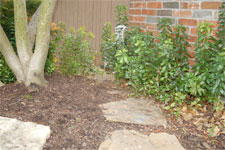
Question: We have several southern wax myrtles. Is there any way to stop these shoots from coming up in our flower and shrub beds? Do I just have to keep cutting them off at the ground? K., Coppell.
Answer: They’re tethered to the mother plant, so there is no weedkiller spray you could safely use to kill them. Were this my bed, I’d probably lift up the stones, rake back the mulch, cut the shoots a few inches below the ground, then come back with a weed-blocking landscape fabric topped by mulch and the stones. That would look neat and tidy, and it would prohibit the sprouts from coming up over and over.
Question: I need your help with my two trees. One is a two-year-old maple, and the other a four-year-old apple. Our soil is tight clay. The trees appear to be infested with something, or at best, very stressed. I believe I can save the maple, but the apple appears to be gone (darker trunk). Any suggestions? M.H., Grand Prairie.
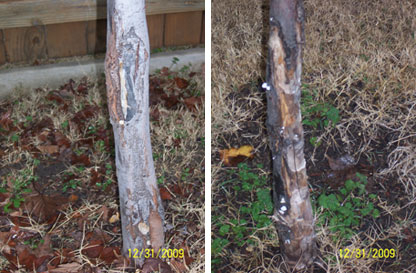
Answer: Neither of these trees is worth trying to save. I agree that the apple is already dead, and the maple isn’t very far behind it. The trunk damage on these trees could be leftover sunscald from when they were first planted, but it also could be from some type of rodent damage done a year or two ago. As young as they are, it would be far better just to start new trees that would be healthy and vigorous, rather than trying to baby these tree(s) back. Go with better quality shade trees such as oaks, cedar elms, pecans or Chinese pistachios. Apples are high-risk trees in the Grand Prairie soils due to the cotton root rot we mentioned in an earlier answer. If you need a medium-sized tree to replace the apple, Little Gem southern magnolia would be one of the best. Redbuds are also good choices for your area.
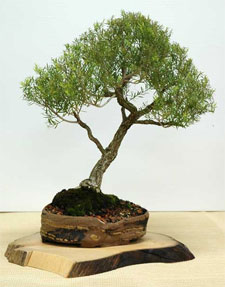
Question: I am an employee of Blue Sky Factory, your e-mail service provider, and a novice garden enthusiast. I recently had occasion to review several accounts within BSF, and by chance was exposed to your newsletter, and, well, I subscribed!
Our office in Baltimore features a three-story, very open east-facing glass atrium that gets tons of morning light. I am interested in starting a small indoor potted garden of mostly cooking herbs and aromatics. I have obtained a couple of 150-watt spotlights to supplement the light in my planned growing area, and based on the health of a couple exceptionally large ficus trees, feel pretty confident in the light conditions and cycle for this spot of our office.
In tending to the ficuses, I have had to battle some scale bugs, and in the course of this, stumbled upon a wonderful solution – tea tree oil. I have been spraying the ficus foliage heavily with diluted tea tree oil, and not only has this effectively checked the scale, but the plants could not be happier.
Have you had any success, or heard much about people growing tea tree plants indoors? S.McG., Baltimore, MD.
Answer: Wow! What a wonderful testimonial. Glad you enjoy e-gardens, and thanks for the challenging question.
Botanically, the tea tree to which you’re referring is Melaleuca alternifolia. Its oil has a camphor-like aroma, and it’s commonly used in cosmetics and deodorants. I have not personally grown the plant, indoors or out, but if the lighting you have is sufficient to keep ficuses happy and vigorous, it probably would be fine for the tea tree, too. Both are sun-loving tropicals. Since you mentioned an interest in growing cooking herbs, we probably should point out that this is not the source of the tea oil used in cooking and seasonings. That’s a derivative of a camellia, of all things, specifically Camellia sinensis.

